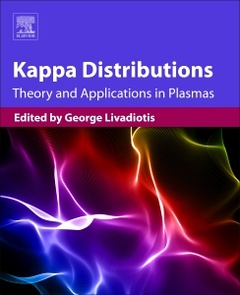Description
Kappa Distributions
Theory and Applications in Plasmas
Author: Livadiotis George
Language: English
Subjects for Kappa Distributions:
738 p. · 19x23.3 cm · Paperback
Description
/li>Contents
/li>Readership
/li>Biography
/li>Comment
/li>
Kappa Distributions: Theory and Applications in Plasmas presents the theoretical developments of kappa distributions, their applications in plasmas, and how they affect the underpinnings of our understanding of space and plasma physics, astrophysics, and statistical mechanics/thermodynamics. Separated into three major parts, the book covers theoretical methods, analytical methods in plasmas, and applications in space plasmas. The first part of the book focuses on basic aspects of the statistical theory of kappa distributions, beginning with their connection to the solid backgrounds of non-extensive statistical mechanics. The book then moves on to plasma physics, and is devoted to analytical methods related to kappa distributions on various basic plasma topics, spanning linear/nonlinear plasma waves, solitons, shockwaves, and dusty plasmas. The final part of the book deals with applications in space plasmas, focusing on applications of theoretical and analytical developments in space plasmas from the heliosphere and beyond, in other astrophysical plasmas.
Kappa Distributions is ideal for space, plasma, and statistical physicists; geophysicists, especially of the upper atmosphere; Earth and planetary scientists; and astrophysicists.
Part 1. Theory and Formalism1. Statistical Background of Kappa Distributions: Connection With Nonextensive Statistical Mechanics - George Livadiotis2. Entropy Associated With Kappa Distributions - George Livadiotis3. Phase Space Kappa Distributions With Potential Energy - George Livadiotis4. Formulae of Kappa Distributions: Toolbox - George Livadiotis
Part 2. Plasma Physics5. Basic Plasma Parameters Described by Kappa Distributions - George Livadiotis6. Superstatistics: Superposition of Maxwell–Boltzmann Distributions - Christian Beck & E.G.D. Cohen7. Linear Kinetic Waves in Plasmas Described by Kappa Distributions - Adolfo Figueroa-Viñas, Rudi Gaelzer, Pablo S. Moya, R. Mace, J.A. Araneda8. Nonlinear Wave–Particle Interaction and Electron Kappa Distribution - Peter H. Yoon & George Livadiotis9. Solitary Waves in Plasmas Described by Kappa Distributions - G.S. Lakhina & Satyavir Singh
Part 3. Applications in Space Plasmas10. Ion Distributions in Space Plasmas - George Livadiotis & David J. McComas11. Electron Distributions in Space Plasmas - Viviane Pierrard & Nicole Meyer-Vernet12. The Kappa-Shaped Particle Spectra in Planetary Magnetospheres - Konstantinos Dialynas, Chris P. Parnicas, James F. Carbary, M. Kane, Stamatios M. Krimigis, Barry H. Mauk13. Kappa Distributions and the Solar Spectra: Theory and Observations - Elena Dzifáková & Jaroslav Dudik14. Importance of Kappa Distributions to Solar Radio Bursts - Iver H. Cairns, Bo Li, Joachi Schmidt15. Common Spectrum of Particles Accelerated in the Heliosphere: Observations and a Mechanism - Lennard Fisk & George Gloeckler16. Formation of Kappa Distributions at Quasiperpendicular Shock Waves - Gary Zank17. Electron Kappa Distributions in Astrophysical Nebulae - D.C. Nicholls, M. A. Dopita, R.S. Sutherland, L.J. Kewley
- Answers important questions, such as how plasma waves are affected by kappa distributions and how solar wind, magnetospheres, and other geophysical, space, and astrophysical plasmas can be modeled using kappa distributions
- Presents the features of kappa distributions in the context of plasmas, including how kappa indices, temperatures, and densities vary among the species populations in different plasmas
- Provides readers with the information they need to decide which specific formula of kappa distribution should be used for a certain occasion and system (toolbox)




